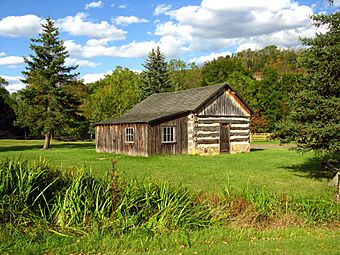Bedford Village Archeological Site facts for kids
Quick facts for kids |
|
|
Site 36BD90
|
|

Reconstructed Euro-American building on the site
|
|
| Location | On the grounds of Bedford Village in Bedford Township, Bedford County, Pennsylvania |
|---|---|
| Area | 4.75 acres (1.92 ha) |
| NRHP reference No. | 84003102 |
| Added to NRHP | June 4, 1984 |
The Bedford Village Archeological Site is a special place in Bedford County, Pennsylvania. It is an archaeological site where scientists study the past. Long ago, a village of the Monongahela culture stood here. These were Native American people who lived in the area.
Today, this site is home to Old Bedford Village. This is an open-air museum where you can see historic buildings. These buildings were moved here from nearby towns like Bedford and Everett. They help visitors imagine what life was like in the past.
Contents
Discovering the Ancient Village
What Was the Monongahela Village Like?
The Monongahela village at this site had round houses. These homes were often surrounded by a stockade, which was a fence made of tall wooden posts. This kind of setup was common for villages of that time.
The village was built on a high spot next to the Raystown Branch of the Juniata River. This location was a bit unusual for the Monongahela people. They usually built their villages on higher ground for protection.
How Long Did People Live Here?
Archaeologists found that the houses in this village were similar to others from the Monongahela culture. One house was about 7 metres (23 ft) (23 feet) across. Experts believe people lived here for a short time, maybe for two generations. This was sometime between the years 1250 and 1600.
From Farmland to Museum
How the Land Changed Over Time
After European settlers arrived, the thick forest at the site was cut down. The land was then used for farming for many years. This continued until the mid-1970s.
Building Old Bedford Village
In 1975 and 1976, something new began. The Bedford County Redevelopment Authority received money to build a living history museum. This museum became Old Bedford Village. It lets people experience history firsthand.
Uncovering History: The Excavations
Early Discoveries at the Site
Before Old Bedford Village was built, local people knew the area had interesting artifacts. But no one fully understood its historical importance until the museum was created. In 1977, tests showed signs of the Monongahela village. They also found evidence of even older settlements from the Late Archaic period.
Big Digs by Pennsylvania State University
In the summers of 1979 and 1980, Pennsylvania State University led bigger excavations. They dug in different parts of Old Bedford Village. These digs uncovered the trenches where the stockade once stood around the village.
How Construction Affected the Site
Building Old Bedford Village did impact some parts of the ancient site. New buildings and roads were put in place. Heavy machines might have buried some old trash piles, called middens. However, about three-quarters of the archaeological site remained untouched. It is unlikely that more areas will be disturbed by the museum in the future.
Why This Site is Important
A Mix of Ancient Cultures
The Bedford Village Site is special because it shows a mix of different Native American cultures. It is one of the most eastern Monongahela sites ever found. This suggests there might have been connections between the Monongahela people and other groups in central Pennsylvania.
Clues About Climate Change
The site's location in a river valley is also interesting. Some experts think that cooler weather around the year 1500 might have made the Monongahela people move from their hilltop homes to warmer river valleys. This site helps scientists study how ancient people adapted to changes in climate.
Evidence of Other Peoples
Archaeologists also found artifacts from the Shenks Ferry culture at the site. This culture lived in eastern Pennsylvania. While there isn't a lot of evidence, it suggests that Shenks Ferry people might have lived here for a short time after the Monongahela. For example, a large Shenks Ferry trash pile was found on top of the Monongahela stockade.
Recognized for Its Value
Because of its many artifacts and how well they were preserved, the Bedford Village Site was added to the National Register of Historic Places in 1984. This means it is a very important historical place.
See also




